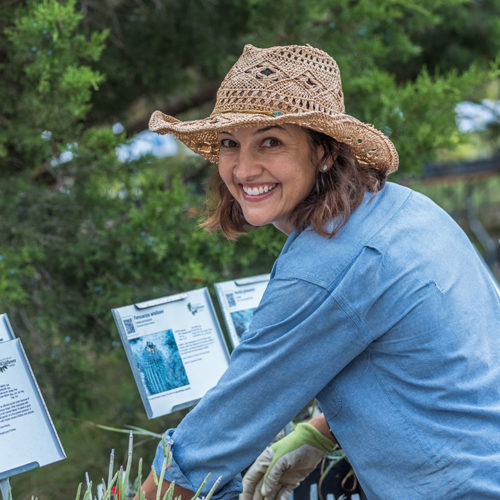
The muhly grass genus, Muhlenbergia, contains over 150 species of grasses and was named after the self-taught German American botanist Gotthilf Heinrich Ernst Muhlenberg (1753–1815). Several grasses in this genus are excellent candidates for Southern Plains gardens. Hardy, drought-tolerant, and easy to care for, they like full or partial sun. Here are my favorites.

Gulf muhly (Muhlenbergia capillaris, Zones 6–10)
Gulf muhly, also known as pink muhly, is perhaps the best-known muhly grass in our region due to its hazy, ethereal pink blooms in the fall. Muhlies are clump-forming grasses, and gulf muhly tends to form a clump about 2 to 3 feet wide and tall. Tall, purplish pink inflorescences appear at the crown and take on a feathery look that is striking in group plantings. A cultivar of Muhlenbergia capillaris called ‘White Cloud’ is a gorgeous alternative to the traditional pink and features soft, white, billowy inflorescences. It blooms a few weeks later than traditional gulf muhly, so interplanting the two will produce a longer muhly bloom season. While some horticulturists recommend cutting gulf muhlies back to a short mound in the winter, I prefer to leave them standing year-round and simply rake them out when they look shaggy with dead leaves.

Big muhly (Muhlenbergia lindheimeri, Zones 7–10)
Big muhly, or Lindheimer’s muhly, is a knockout star for borders and backdrops. At full size it is larger than gulf muhly (about 3 to 4 feet wide and tall) and has a more upright form. Instead of delicate pink inflorescences, big muhly makes sturdier silver seed heads, which contrast beautifully with its blue-green foliage. It is large enough and stately enough to use as a screening plant and is a handy substitute for Pampas grasses (Cortaderia selloana, Zones 8–10). Big muhlies are extremely drought tolerant once established and suffer no major pests. As for care, many landscapers pressed for time cut them down to small mounds in the winter, which leaves them vulnerable to rot from accumulated rainfall. The ideal winter treatment for big muhlies is to burn them in a controlled burn, although this is not a viable option in most situations. Alternatively, I let them stand through the winter, as the dried seed stalks add visual interest. Then in early spring I cut out the dried stalks and rake the foliage from bottom to top to remove dead leaves.

Pine muhly (Muhlenbergia dubia, Zones 7–10)
If a big muhly is too big for your particular situation, then the pine muhly might be just right. Standing only about 2 to 3 feet tall, it has a rather stiff, upright appearance and whitish-tan seed heads. It has a slightly more formal look than the airier gulf muhly and prefers drier conditions. Pine muhlies work especially well in poor, rocky soils, since they are native to rocky outcroppings in the Trans-Pecos mountains in West Texas.

Seep muhly (Muhlenbergia reverchonii, Zones 5–10)
Seep muhlies do fine in dry to moist soils but are often found near seeps in the wild. This makes them a nice candidate for planting near water features in a cultivated garden. They are about 1 to 3 feet wide and tall and resemble a puffball of wiry, curling grass. Their seed heads range in color from white to pink, although they are not as pink or as showy as the gulf muhlies. Seep muhlies are more notable for the curling mass of basal sheaths that give it its puffball appearance. This muhly is a good candidate for gardens in more northern climates, as it is cold hardy down to Zone 5.
I have found muhly grasses to be dependable and handsome garden additions. They can take abuse and neglect and still hold their own as attractive border plants. In contrast to more tender grasses and herbaceous plants, the muhlies I’ve profiled here hold their architectural value through the winter and come back strong every spring with fresh green growth and then again in the fall with their distinctive seed heads.
Karen Beaty is a horticulturalist at the Lady Bird Johnson Wildflower Center in Austin, Texas.


















Comments
Log in or create an account to post a comment.
Sign up Log in